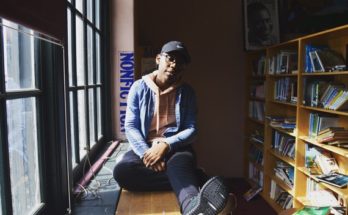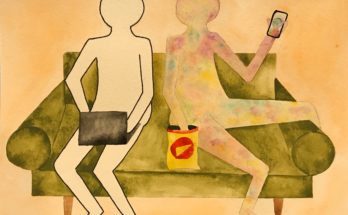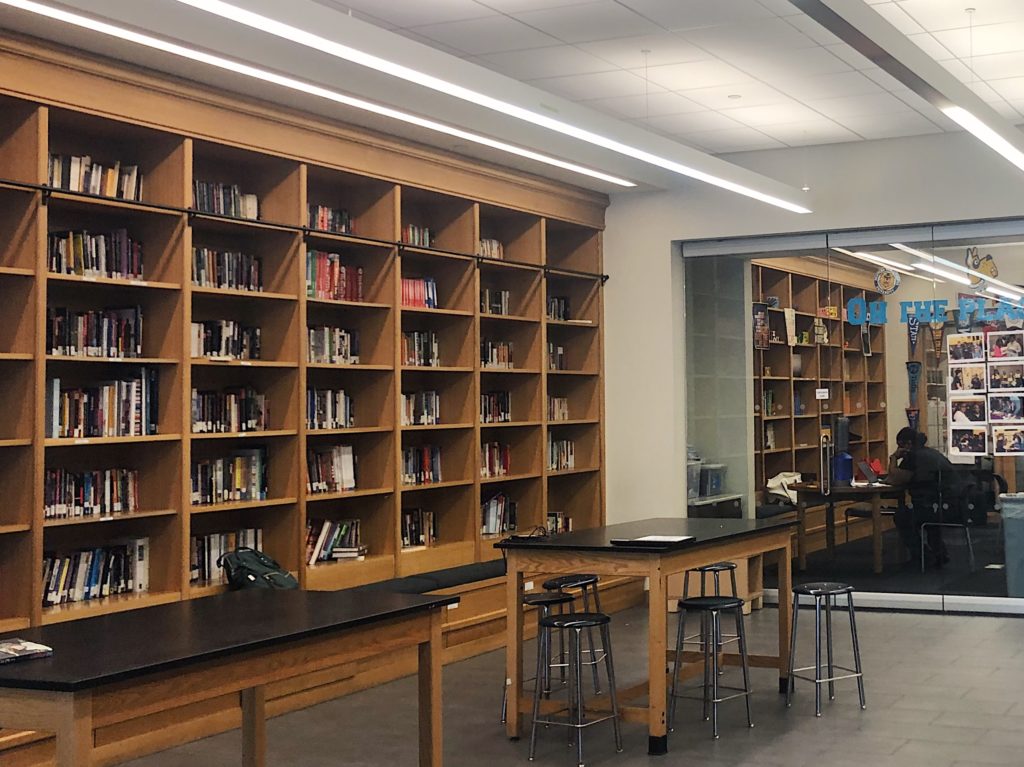
Photo credit: Cayla Bamberger
For 14 years, Doreen Wright has thrown herself into her role as teacher-librarian on the Richard R. Green public school campus in Williamsbridge, the Bronx. There, she supports sixth through eighth graders at two co-located schools, the North Bronx School of Empowerment and Leaders of Tomorrow—about 1,000 teenagers each year.
Above all, she loved her library, a resource over 700 of the 1,580 schools in New York City don’t have, according to state data. Three years ago, both Richard R. Green principals purchased brand new books for the campus, and Wright was given the go-ahead to remodel the library. With the help of an independent media library specialist, she redid the space: now a light blue room with wall-to-wall shelves, a flat screen TV, and many tables and chairs. She also ordered more books—“all hardcover,” she beamed. “It’s amazing.”
Like the rest of the Richard R. Green building, today the library is deserted; locked-up since mid-March to contain the spread of COVID-19. “I really miss that space at this point,” she said. “The virtual experience is—in my opinion—not as good as a tangible book.”
As hard as it is for Wright’s students to lose their once-bustling space, almost half of New York City schools never had libraries before the pandemic.
An official count of school libraries has long been hard to pin down. For a period of a few years, city schools didn’t respond to the state education department’s Basic Educational Data System (BEDS) questions related to school libraries.
Using state data collected in 2018, Dr. Michael Radlick and a team of researchers at SUNY Albany were able to find that about 45 percent of schools can’t access a library. Of the ones that could, over a quarter shared the space with another school. For a comparison, 13 percent of city schools across the nation did not have libraries, according to the most recent National Center for Education Statistics (NCES) data.
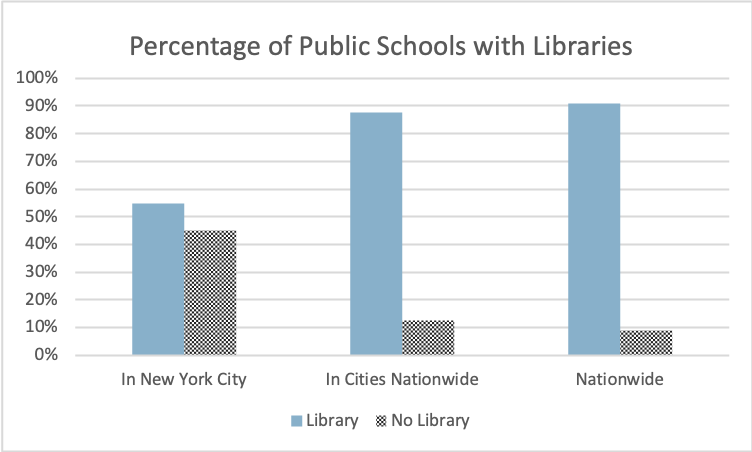
The number of distinct school libraries in the city nosedived from around 1,500 in 2005 to about 600 in the fall of 2018, according to the state. Librarians and their advocates say that’s a problem for today’s children, who are missing out on a safe, social space to cultivate literacy and a love of reading.
Also, just because a space exists doesn’t mean it functions as a library. Debra Kachel, a national school librarian researcher and co-chair of the Pennsylvania School Librarians Association’s advocacy committee, described how schools that cut librarians can reach this point: “As the collection ages with no one selecting new titles,” she said, “students and teachers stop using the library. Next step, books are moved to classrooms, and the library space reclaimed for other purposes”—a classroom, special education area, or large study hall.
Coast to coast, trends also emerge tied to average population wealth. According to NCES data, 87 percent of schools with most students approved for free lunch (an indicator of economic need) had libraries; meanwhile, almost all schools with just under half had libraries—97 percent. In New York, three quarters of school-aged children are eligible for the program.
“There is little doubt,” said Keith Lance, a government agency and professional association consultant for library research, “based on anecdotal accounts, that access to school library spaces is becoming increasingly and very problematically inequitable.” Lance predicts that the COVID-19 fiscal crisis could “make this problem far worse before it gets better.”
Gifted & Talented students at Hunter College Elementary School, of which less than 3 percent come from low-income families, are fortunate to have an outstanding library. Hunter-parent Mimi Glenn Umscheid, who volunteered at the school’s library for two years, said most lessons work well online—like reading books related to their classes and voting on their favorites for awards.
However, it’s harder for Umscheid’s daughter to look for books on her own while remote. Back in the space, the first grader knew exactly where to find the “easy readers,” titles for her age level, grouped together in the middle of the library. “I think it’s a way to make it easier for the kids,” Umscheid said, whose daughter adores graphic novels.
On average, students on the Richard R. Green campus come from more disadvantaged backgrounds than those at Hunter. Over half the population is black and over a third Latino, and almost 14 percent are English language learners, according to last year’s city and state data. About a quarter of students were homeless at some point over the past four years.
But Wright still sought to give her students an experience like the children at Hunter. “There was always something going on in the library,” she said. Students flocked in and out to borrow and return books during their lunch breaks. Wright organized themed campaigns around Women’s History Month and Black History Month, and invited classes for book talks and author interviews. She also taught concepts in reading, like inferencing and context clues, and planned scavenger hunts based on the Dewey Decimal System, a sorting method for library books.
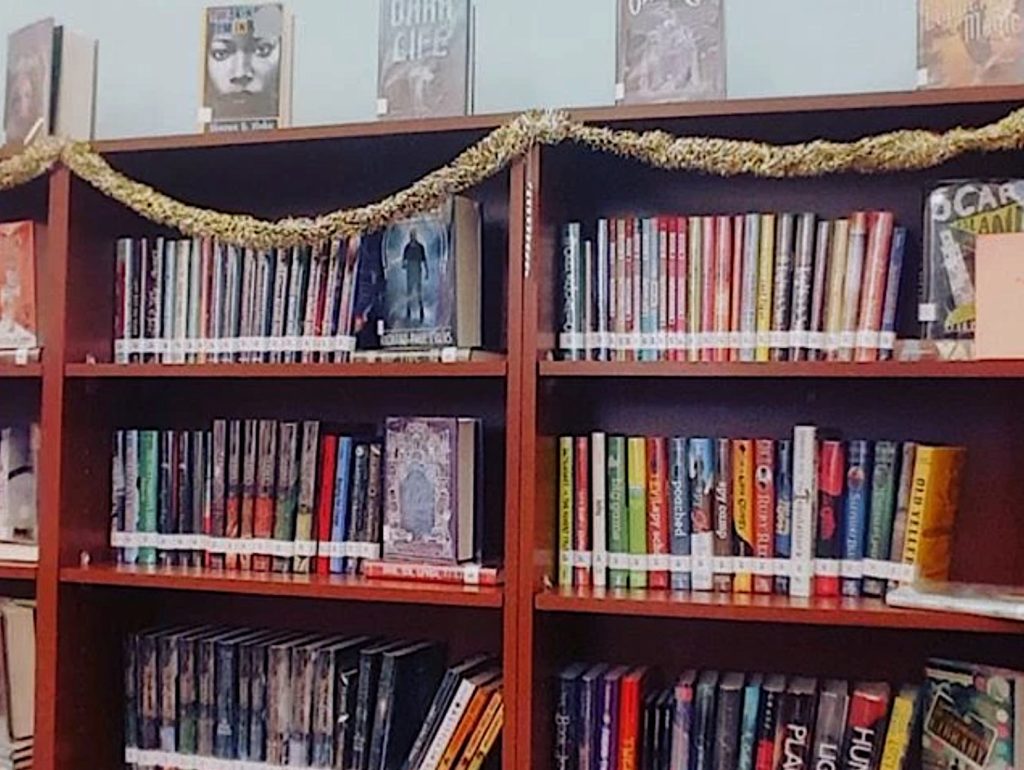
Photo credit: Doreen Wright
Then came the coronavirus. “At least a digital library was up and running,” said Wright, “but it wasn’t as functional as I would have liked—to prepare for something like this.”
“I didn’t know how to remain relevant as the librarian online,” Wright confessed, so she contacted the experts: her students. “Reaching out to individual students that visited the library more frequently, and asking them about what they like to read or how COVID-19 is an experience for them, has helped a lot.”
In the months since, Wright spearheaded many projects, including a digital yearbook-montage for this year’s graduates and grade-wide book clubs to recreate communal feeling online. Knowing her students from the shared space helped her choose engaging texts related to their circumstances. She could hardly contain her excitement about what books to assign. “I have like 1,000 tabs open in my head,” she said.
Still, Wright wonders what the loss of the physical space of the library will mean for this generation of children. “Some students are raised with books in the house,” she said. “Those that aren’t, the library space in the building is probably the only place they can get to on a daily basis, in order to engage with books.”
Before the pandemic, there was still a middle ground. While some schools didn’t have centralized libraries, they did have books in the classrooms. A number of charters made this choice purposely, like the Success Academy Charter Schools.
But for many students, the library space is more than a receptacle of books. “Kids like going to the library, because usually going to the library means you’re going to do something interesting and fun,” said Arlene Laverde, the president of the New York City School Librarians’ Association and a librarian at Townsend Harris High School in Queens. “There are no tests, exams, homework, or parent-teacher conferences.”
Laverde is not alone in this sentiment. “School libraries serve as a safe, ‘third place’ for students seeking a break from academic stresses,” said Debra Kachel, the school librarian researcher. “You cannot discount the impact of school libraries on the social and emotional health of many of our at-risk students.”
Fostering positive feelings toward libraries and books has a practical purpose, too. “When students love to read, their literacy improves, their scores improve, their opportunities improve,” said Wright. In a brief prepared for the state education department, the New York Comprehensive Center (NYCC) found that by exposing children to books, school libraries increase the likelihood that students will read voluntarily.
“Children deserve to know how it feels to be surrounded by books,” said Wright. “Every school should have a library.”
Additional reporting by Claire Bryan.
Where are the school libraries in New York City?
Map of staffed libraries by the New York City Department of Education
Data was collected by surveying library workers and is not a complete list

